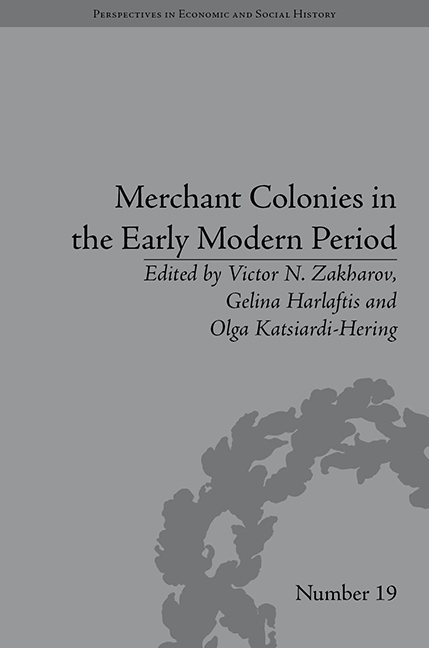Book contents
- Frontmatter
- Contents
- List of Figures and Tables
- List of Contributors
- Introduction
- 1 Early Modern English Merchant Colonies: Contexts and Functions
- 2 German and Italian Merchant Colonies in Early Modern England
- 3 Dynamism and Integration of the North European Merchant Communities in French Ports in the Eighteenth Century
- 4 Opportunity and Legislation: How the Armenians Entered Trade in Three Mediterranean Ports
- 5 Russian Merchant Colonies in Seventeenth-Century Sweden
- 6 Foreign Merchant Communities in Eighteenth-Century Russia
- 7 Greek Merchant Colonies in Central and South-Eastern Europe in the Eighteenth and Early Nineteenth Centuries
- 8 Community for Commerce: An Introduction to the Nezhin Greek Brotherhood Focusing on its Establishment as a Formal Institution in the Years Between 1692 and 1710
- 9 Entrepreneurship at the Russian Frontier of International Trade. The Greek Merchant Community/Paroikia of Taganrog in the Sea of Azov, 1780s–1830s
- Notes
- Index
3 - Dynamism and Integration of the North European Merchant Communities in French Ports in the Eighteenth Century
- Frontmatter
- Contents
- List of Figures and Tables
- List of Contributors
- Introduction
- 1 Early Modern English Merchant Colonies: Contexts and Functions
- 2 German and Italian Merchant Colonies in Early Modern England
- 3 Dynamism and Integration of the North European Merchant Communities in French Ports in the Eighteenth Century
- 4 Opportunity and Legislation: How the Armenians Entered Trade in Three Mediterranean Ports
- 5 Russian Merchant Colonies in Seventeenth-Century Sweden
- 6 Foreign Merchant Communities in Eighteenth-Century Russia
- 7 Greek Merchant Colonies in Central and South-Eastern Europe in the Eighteenth and Early Nineteenth Centuries
- 8 Community for Commerce: An Introduction to the Nezhin Greek Brotherhood Focusing on its Establishment as a Formal Institution in the Years Between 1692 and 1710
- 9 Entrepreneurship at the Russian Frontier of International Trade. The Greek Merchant Community/Paroikia of Taganrog in the Sea of Azov, 1780s–1830s
- Notes
- Index
Summary
The large commercial areas of the Ancien Régime, in particular the major ports, attracted capital as well as people and became the driving force of economic activity in western Europe. The migrants were first of all the inhabitants of near regions who came looking for work and better living conditions. Then, with the development of international exchanges, populations from afar, attracted by the desire to speculate and to make their fortune in commerce and trade, arrived in great number. Among these, the group of foreigners made itself noticed by its dynamism and its stimulating role in commerce in their adopted towns.
‘Cosmopolitanism seems to be a characteristic feature of all international emporium’, and the foreign merchants contributed to running the economic activity in the large French ports. The importance of a commercial centre could be measured by the size of the presence of the merchant communities from different European countries. This contribution was very dynamic and, apart from the people who settled for a more or less long period, maybe even finally in their host port, the circulation of these men was the second feature of this group of foreigners. According to the historian Jean Meyer: ‘The Atlantic front of Europe from Copenhagen to Cadiz was being covered by a ceaseless flow of merchants, young people: cousins (male and female) trainee merchants who created both friendships and often even marriage.’
- Type
- Chapter
- Information
- Merchant Colonies in the Early Modern Period , pp. 45 - 60Publisher: Pickering & ChattoFirst published in: 2014



